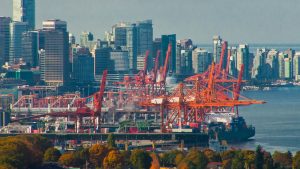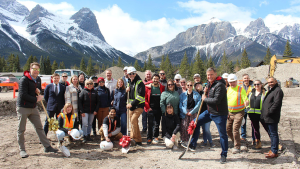The ad for what Joe Gvozdanovich’s company does might read something like this – “For sale, one used, but still good, steel building. We deliver.”
Recycling
VANCOUVER
The ad for what Joe Gvozdanovich’s company does might read something like this – “For sale, one used, but still good, steel building. We deliver.”
JDG Construction in North Vancouver is one of a few Canadian companies that will go onto a site, evaluate a steel structure and determine whether it can be taken down, stored and sold to a new buyer for erection again.
Such pre-owned and pre-engineered steel buildings are advertised on the company’s web site (www.jdgconstruction.ca).
Recently the company sold a port rail terminal building located in northern B.C. “We had built it in 1999,” says Gvozdanovich, whose 25-year company specializes in steel building construction. “So, we knew the building and knew it was coming down.” The owner of the structure had changed location and it along with four others was put on the market for removal, tells Gvozdanovich.
Pre-owned buildings are not usually something that his construction firm gets a lot of calls on, he admits. However, the number of calls that came in recently for this building surprised him. The interest, he credits, to a number of reasons.
“I think it’s timing, (the growing lag in getting new buildings designed and the skills shortages on site) the shape of building (it was an irregular) and the Internet (where the used buildings are advertised),” he says.
But, to make pre-owned buildings work, “the economics have to be there” says Gvozdanovich, who approximates a building’s value at about $1 per square foot. That’s not a lot of economic wiggle room and companies like JDG Construction have to wield a sharp pencil to make sure it’s an economic fit.
The economics, tells Gvozdanovich, go beyond simply the cost of taking the building down and shipping it to a new owner. “You can’t take a building from Richmond and place it in Castlegar,” he says, as the original structure is built for a different snow-load rating.
As well, any structure built years ago would have to go through the extra cost of conforming to newer more stringent building code requirements.
The amount of labor required to disassemble and erect again the structure is always a factor and places a constraint on what can be salvaged on a site, says Gvozdanovich, acknowledging that “labor is a killer”.
Another big factor that determines whether his company would buy a building that is to be removed from site for resale is whether the engineer’s drawings are available. “We would probably not purchase it if the original drawings and design where not available,” he says, adding that such drawings are integral to not only taking a building down but determining where it might be resituated and what modifications are needed to meet new code standards.
The B.C. port structure recently salvaged was originally constructed to load and off-load rail cars but saw little use. The total building roof area was 65,940 square feet. “This building was particular – it was an irregular shape,” he says, adding it was just the structure the buyer located in Manitoba wanted to turn into a commercial complex. “He said he couldn’t have picked a better lay-out.”
The interest in recycled buildings isn’t linked to the growing trend to recycle building materials. Steel is basically a recycled material as 80 per cent of its content comes from recycled domestic goods, he points out. “I don’t think its really anything as glorious as wanting to be friendly to the environment – I think it’s basically just wanting to gain an economic advantage,” he says.
The business is such that it usually comes to his doorstep, he says. He’s currently taking down a building in Nanaimo. It was an engineered structure 60 by 100 square feet with a 22-foot height.
“It was being used as a shipping terminal building for a courier,” he says, and as such has no interior columns. “The nice thing about pre-engineer buildings is you can create these large 60 foot spans,” he says. The structure can be used as a storage area or retail centre.
Another area of business comes from temporary, pre-engineered structures. Gvozdanovich says he’s also got a 5,000 square foot building coming up which has been used as temporary facility. These are buildings that are used to fill an owner’s short-term needs (construction or real estate) for periods of up to a year and then are no longer required on site.
Pre-engineered structures, he says, have market appeal for secondary buyers because of their versatility. They can be covered with a variety of exterior claddings to provide the required look the new buyer wants. For more information, see JDG Construction’s web site.










Recent Comments
comments for this post are closed